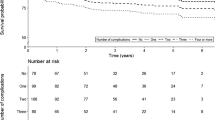Abstract
Summary
This study retrospectively reviewed 327 nonagenarians who underwent hip fracture surgery at six hospitals. Functional status, postoperative complications, and 1-year mortality were evaluated, and relationships between these factors and American Society of Anesthesiologists (ASA) grade were analyzed. ASA grade was significantly associated with postoperative complications and 1-year mortality.
Introduction
Few previous studies have reported outcomes after hip fracture in nonagenarians, and these studies did not report significant associations between ASA grade and mortality. However, most of these studies included only a small number of patients from a single hospital. This study aimed to evaluate the relationships between ASA grade and functional status, postoperative complications, and mortality rate in nonagenarians undergoing hip fracture surgery.
Methods
This study included 327 nonagenarians who underwent hip fracture surgery between January 2000 and December 2012. Patients with open fractures, subtrochanteric fractures, polytrauma, and pathological fractures were excluded. The medical records and X-rays were retrospectively reviewed. The relationships between ASA grade and functional status, postoperative complications, and 1-year mortality were analyzed.
Results
There were significant associations between the ASA grade and the rates of postoperative complications and 1-year mortality (both p < 0.05). All pairwise comparisons showed significant differences in postoperative complication rates between ASA grades (all p < 0.05). All pairwise comparisons, except for grades I vs. II and grades II vs. III, also showed significant differences in mortality rates between ASA grades (all p < 0.05). There were significant associations between the preoperative ability to manage activities of daily living and the rates of postoperative complications and 1-year mortality (both p < 0.05).
Conclusions
ASA grade was significantly associated with the rates of postoperative complications and 1-year mortality in nonagenarians undergoing hip fracture surgery. The preoperative functional status was also significantly associated with these outcomes.

Similar content being viewed by others
References
World health Organization. Media centre fact sheets-falls.http://www.who.int/mediacentre/factsheets/fs344/en/index.html. Accessed 2013 Feb 23
Ooi L, Wong T, Toh cL, Wong HP (2005) Hip fractures in nonagenarians-a study on operative and non-operative management. Injury 36:142–147
van de Kerkhove M, Antheunis pS, Luitse JS, Goslings J (2008) Hip fractures in nonagenarians: perioperative mortality and survival. Injury 39:244–248
Ag M, Bercik MJ, Ong A (2012) Nonagenarian hip fracture: treatment and complications. J Trauma Acute Care Surg 72:1411–1415
Hagino T, Maekawa S, Sato E, Bando K, Hamada Y (2006) Prognosis of proximal femoral fracture in patients aged 90 years and older. J Orthop Surg 14:122–126
Maccollum MS, Karpman RR (1989) Hip fractures in nonagenarians. Orthop Rev 18:471–477
Holt G, Smith R, Duncan K, Hutchison JD, Gregori A (2008) Outcome after surgery for the treatment of hip fracture in the extremely elderly. J Bone Joint Surg Am 90:1899–1905
Kadowaki M, Kono M, Nishiguchi K, Kakimaru H, Uchio Y (2012) Mortality in patients with hip fracture aged over 90 years: a report from a progressively aging island. Arch Gerontol Geriatr 54:e113
Formiga F1, Lopez-Soto A, Sacanella E, Coscojuela A, Suso S, Pujol R (2003) Mortality and morbidity in nonagenarian patients following hip fracture surgery. Gerontology 49:41–45
Shah MR, Aharonoff GB, Wolinsky P, Zuckerman JD, Koval KJ (2001) Outcome after hip fracture in individuals ninety years of age and older. J Orthop Trauma 15:34–39
Ag J, Boer P (1999) Should we operate on nonagenarians with hip fractures? Injury 30:169–172
Tay YW, Hong CC, Murphy D (2014) Functional outcome and mortality in nonagenarians following hip fracture surgery. Arch Orthop Trauma Surg 134:765–772
Haronoff GB, Koval KJ, Skovron ML, Zuckerman JD (1997) Hip fractures in the elderly: predictors of one year mortality. J Orthop Trauma 11:162–165
Keene G, Parker MJ, Pryor G (1993) Mortality and morbidity after hip fractures. B Med J 307:1248–1250
Ben Dhaou Hmaidi B, Boussema F, Aydi Z et al (2011) Urinary tract infections in elderly. Tunis Med 89:920–923
Conflicts of interest
None
Author information
Authors and Affiliations
Corresponding author
Additional information
Minghui Peng and Yueju Liu contributed equally to this paper.
Rights and permissions
About this article
Cite this article
Liu, Y., Peng, M., Lin, L. et al. Relationship between American Society of Anesthesiologists (ASA) grade and 1-year mortality in nonagenarians undergoing hip fracture surgery. Osteoporos Int 26, 1029–1033 (2015). https://doi.org/10.1007/s00198-014-2931-y
Received:
Accepted:
Published:
Issue Date:
DOI: https://doi.org/10.1007/s00198-014-2931-y




